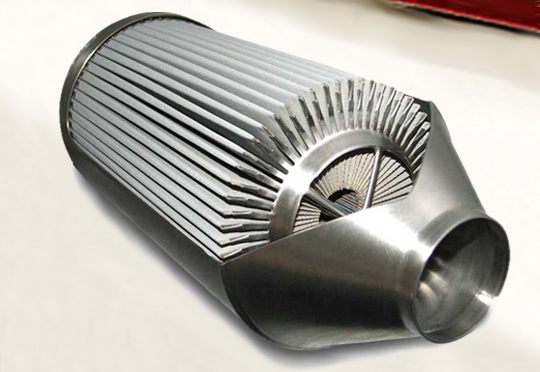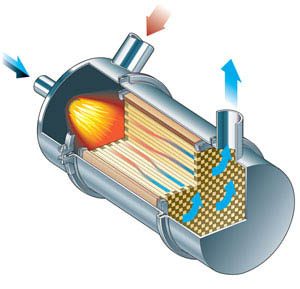What is Diesel particulate filter ?
Diesel Particulate Filters (DPF) are devices that physically capture diesel particulates to prevent their release to the atmosphere. Diesel particulate filter materials have been developed that show impressive filtration efficiencies, in excess of 90%, as well as good mechanical and thermal durability. Diesel particulate filters have become the most effective technology for the control of diesel particulate emissions—including particle mass and numbers—with high efficiencies.

How Diesel Particulate Filters Work
As with any filter, they ‘filter’ or trap particles, in this case harmful diesel exhaust soot particles, so they have to be emptied regularly to maintain performance. The DPF needs to be cleaned regularly, through a process called regeneration, either active, passive or forced regeneration, the accumulated soot is burnt off at high temperature (around 600°c) to leave only a residue of ash, effectively renewing or regenerating the filter, ready to take on more pollution from the engine.
Regeneration of Diesel Particulate Filters
Diesel Particulate Filters (DPF) have high efficiency on dust grain filtration, it up to 60%~90%.During filtering, the accumulation of particles in the particulate filter will lead to diesel engine back pressure rise.When the diesel engine pressure reached 16 kPa~20 kPa,the diesel engine performance began to deteriorate.So we need to clean particle regularly to restore DPF working state, it call DPF regeneration.
The biggest challenge of DPF is the regeneration problem.Particulate filter main method is particulate oxidation,and particulate oxidation elements are high temperature,oxygen and oxidation time,.But in fact the diesel engine exhaust temperature is generally less than 500 ℃, especially in some bus exhaust temperature even below 300 ℃. The key problem of particle filter regeneration is to reduce the equilibrium point temperature which the formation of particles and oxidation rate is equal in.when the back pressure is relatively constant, the system is in equilibrium.The balance point temperature is relevant with flow rate,particle composition,NOx content,sulfur concentration,charcoal formation and engine,fuel parameters.
Here is some guide on regenerate DPF:
Ford Diesel Particulate Filter (DPF) Static Regeneration Guide
How To Regenerate DPF Filter By Yourself
Diesel particulate filter clean classify:
There are two types of generation:active and passive.
DPF Active Regeneration:
Positive Diesel Particulate Filter Regen divide into burner fuel injection heating regeneration,electric heating regeneration,microwave heating regeneration and infrared heating regeneration.

Burner fuel injection heating regeneration:
Install a burner at the inlet of the particulate filter,injects diesel and secondary air, and burns the charcoal particles in the particulate filter to regenerate.It requires the provision of additional fuel and requires a constant burner temperature,therefore requires a set of automatic adjustment control systems that regulate fuel and secondary air supply value.And this burner on the vehicle driving have certain requirements, requiring regeneration can not be accelerated when the acceleration. If the rapid acceleration of regeneration will make the air to extinguish the regeneration of the flame, so that the fuel is not completely burned, causing the phenomenon of vehicles to smoke white smoke.
Electric heating regeneration:
Electric heating regeneration which heating the particle filter by electric heating to promote the smoke particles burning.Although this kind of regeneration method will not have any smoke phenomenon, but the electric heating requirements are really high, and need to solve the problem of high power consumption,Small and medium power diesel engine is not easy to meet the energy requirements. In addition, the heating of the non-uniformity will cause the filter body regeneration is not uniform, the filter is easy to overheat and damage.
Microwave heating regeneration
Microwave heating regeneration is the use of microwave unique choice of heating and volume heating characteristics, the formation of a spatial distribution within the filter heat source, the deposition of carbon particles on the filter body heating, so that the ash particles in situ heating fire burning.To achieve the filter body regeneration Microwave heating is the frequency of 300 MHz ~ 300 GHz on the object heating, which is different from the general heating method is the material in the electromagnetic field caused by the dielectric loss of body heating, the energy through the space or medium to electromagnetic waves The transfer of the process is closely related to the polarization of the molecules inside the material. The key technology of microwave heating regeneration is how to encourage as much as possible in the resonant cavity and control the burning temperature of the soot particles in the cavity to prevent the filter from being damaged by the high temperature.
Infrared heating regeneration
Infrared radiation heating regeneration method compared with other heating methods, with the characteristics of selective heating, can directly heat the heating body, shorten the heating body to the required temperature of the time to reduce energy consumption; infrared regeneration technology, high efficiency; Temperature suitable, the filter body temperature gradient is very suitable for honeycomb ceramic regeneration. These advantages of infrared radiation heating are closely related to their heating mechanism. From the mechanism of infrared radiation heating, when the radiation wavelength of the radiation source is consistent with the absorption wavelength of the radiation, the latter absorbs a large amount of infrared energy to change And exacerbate the movement of its molecules, to achieve the role of heating heating.
DPF Passive Regeneration:
Commonly used passive regeneration methods are fuel additive catalytic regeneration filter system, CRT (continuous regeneration filter) system and CCRT system.
Fuel Additive Catalytic regeneration The fuel additive for the filter system is a fuel-soluble catalyst. In the engine after combustion into the exhaust, and particles together by the filter to capture, which makes the particles and catalytic active components in close contact, equivalent to adding particles in the particles, to reduce the regeneration temperature of particles.
CRT consists of an oxidizer (DOC) and a particulate trap (DPF without catalytic coating). When the diesel exhaust through the oxidation catalytic converter, the temperature at 200 ℃ ~ 600 ℃ conditions, CO and HC first almost all of the oxidation of carbon dioxide and water, NO is converted to NO2. And then NO2 oxidation of particulate particles in the particles to generate CO2, and NO2 has been reduced to NO, so as to achieve the purpose of renewable particles.
CCRT system is also composed of an oxidizer (DOC) and a particulate trap (DPF), but the CCRT particulate tractor carrier (DPF) is coated with a catalyst such that the NO generated in the oxidizer continues in the particulate trap NO2 can be produced to oxidize the particles so that the system can more completely remove the particulate matter from the filter. The advantage of the CCRT system is that it makes the regeneration of the system more relaxed, lower exhaust temperature and lower NOx / PM ratio in the exhaust system.